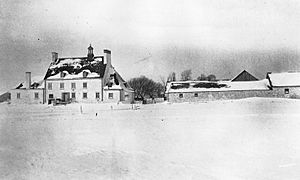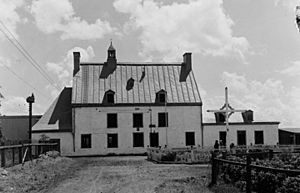Maison Saint-Gabriel facts for kids
 |
|
| Lua error in Module:Location_map at line 420: attempt to index field 'wikibase' (a nil value). | |
| Established | March 1966 |
|---|---|
| Location | Pointe-Saint-Charles, Le Sud-Ouest, Montreal, Quebec, Canada |
| Type | History museum |
| Public transit access | |
The Maison Saint-Gabriel Museum in Montreal, Quebec, is a special place. It helps us learn about the history of early settlers in New France (what Canada was called long ago) from the 1600s. The museum is on an old farm. Nuns called the Sisters of the Congregation of Notre Dame of Montreal have looked after it for over 300 years. This group was started by Marguerite Bourgeoys in 1658. The site became a National Historic Site of Canada in 2007. This means it's a very important place in Canadian history.
Contents
How It Started
On October 31, 1662, Paul de Chomedey de Maisonneuve gave land in Pointe-Saint-Charles to Marguerite Bourgeoys. The idea was to start a farm there. This farm would grow food for the Sisters of the Congregation of Notre Dame. Workers called engagés helped clear the land. They planted crops like corn, wheat, and pumpkin. These workers also helped protect the Sisters from attacks.
In 1668, Marguerite Bourgeoys bought more land next to hers. This new land had a house and a barn on it. This house later became known as the Maison Saint-Gabriel. Sister Catherine Crolo was in charge of the farm and house at first. She planned the work, planting, and harvesting. She also made sure the food got to the community. Sister Crolo also looked after the other Sisters.
A Special School
In its early days, the farm did more than just grow food. It was also a special school for young women. Some girls came there before moving to Montreal. Others were Filles du Roi (King's Daughters). These girls were brought from France to New France. The goal was for them to marry the many single men in the colony. This helped the population grow between 1663 and 1673.
The House and Farm Over Time
In 1693, the old farmhouse burned down. But its strong foundation and the creamery (where butter was made) survived. These parts were used when the house was rebuilt. The new house was finished in 1698. Skilled workers like masons and carpenters led this project. The new house had two floors, a strong oak frame, and ash beams. Its design showed what 17th-century buildings looked like.
In the early 1700s, the Sisters bought more land around the house. This helped them keep the farm going and make it bigger. Throughout the 1700s, they grew wheat and oats. They also built a chicken coop, a barn, and stables. In the 1800s, the farm animals helped produce butter, wool, soap, and leather.
Changes in the 1800s
The Maison Saint-Gabriel changed a lot over the years. Montreal grew bigger and became more industrial. More people moved to the city. Because of this, some of the farm's land was sold. New houses were built there. The building of the railway and the opening of the Lachine Canal also brought fast growth to Pointe-Saint-Charles. From the 1850s on, the farm's land slowly became part of the growing city.
Becoming a Museum
In the early 1960s, people became very interested in turning the old house into a museum. This happened after they celebrated 300 years since Marguerite Bourgeoys first owned the land. To make it a museum, the Sisters needed a new place to live. So, the Jeanne-LeBer house was built between 1963 and 1964.
The Maison Saint-Gabriel, the original farmhouse, was named a historic monument in October 1965. This was done by the Ministère de la Culture, des Communications et de la Condition féminine. Work began that same year to fix up the house. Architect Victor Depocas oversaw the project. The goal was to make the house look like it did when the Sisters lived there in the 1600s. The kitchen, common room, basement, chapel, and other rooms were restored. They were filled with old objects to show what life was like back then.
During the summer, you can see people dressed in old costumes. They show how crafts were made in the 1600s. The house and barn are also surrounded by beautiful gardens. The Glade and Poetry Path have native plants. The Farmhouse Gardens show what a 17th-century vegetable garden looked like. The Sharecroppers' garden honors the women of the Congregation of Notre Dame. These gardens make the museum even more special.
Museum Collections
The Maison Saint-Gabriel museum has over 15,000 old objects. The 17th-century house and 18th-century barn hold a collection that helps show what rural life was like in New France. Some objects are original, while others are copies made from old drawings. The collection includes things like old lamps, religious clothes, furniture, letters, books, art, and tools for farming and trades.
Museum Expansion
On November 1, 2010, the Jeanne-Leber house became part of the museum. It is now called the Catherine-Crolo pavilion. This building has a gift shop with a tea room. It also has a reception area and a room for cultural events. The Canadian and Quebec governments helped pay for this project. They support the museum because it helps teach visitors about the history of Marguerite Bourgeoys and the Sisters.
Images for kids




